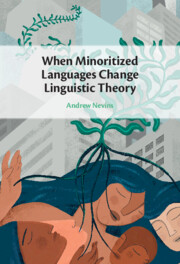Book contents
- Frontmatter
- Dedication
- Frontmatter
- Contents
- Figures
- Acknowledgments
- Abbreviations
- Map
- 1 Expanding the Canon: Minoritization in the World and in Linguistic Theory
- 2 Indexical Shift in Zazaki and Uyghur
- 3 Why Ergative Case Requires Structure in Basque and Ch’ol
- 4 Closest Conjunct Agreement in Slovenian and Xhosa
- 5 Configurationality of Objects in Chichewa and Warlpiri
- 6 Partial Nasality in Maxakalí and Kaingang
- 7 Symmetric Hands in Sign Language Phonologies
- 8 Number-Encoding on Verbs in Hiaki and Chechen
- 9 Conclusion: Towards Healthy Futures in the Language Sciences
- Bibliography
- Index
6 - Partial Nasality in Maxakalí and Kaingang
Published online by Cambridge University Press: 18 November 2022
- Frontmatter
- Dedication
- Frontmatter
- Contents
- Figures
- Acknowledgments
- Abbreviations
- Map
- 1 Expanding the Canon: Minoritization in the World and in Linguistic Theory
- 2 Indexical Shift in Zazaki and Uyghur
- 3 Why Ergative Case Requires Structure in Basque and Ch’ol
- 4 Closest Conjunct Agreement in Slovenian and Xhosa
- 5 Configurationality of Objects in Chichewa and Warlpiri
- 6 Partial Nasality in Maxakalí and Kaingang
- 7 Symmetric Hands in Sign Language Phonologies
- 8 Number-Encoding on Verbs in Hiaki and Chechen
- 9 Conclusion: Towards Healthy Futures in the Language Sciences
- Bibliography
- Index
Summary
This chapter explores the contributions of two minoritized indigenous languages of Brazil, Maxakalí and Kaingang, to representations of nasality gestures akin to musical scores, as well as the right way to frame the universality of the kinship terms (and ideal universal syllables)' mama’ and ‘papa’ in light of a phonetic model called Enhancement Theory. These languages have either the consonants /m/ and /p/, but not /b/, or /b/ and /p/, but not /m/, and the allophonic environments in which this available phonetic space is used are organized around perceptual and articulatory optimization.
- Type
- Chapter
- Information
- When Minoritized Languages Change Linguistic Theory , pp. 84 - 98Publisher: Cambridge University PressPrint publication year: 2022

